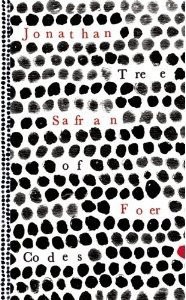Currently reading
Financial Intelligence: A Manager's Guide to Knowing What the Numbers Really Mean
The Cambridge Companion to Jane Austen
Hildegard of Bingen: A Spiritual Reader
Tree of Codes
 Jonathan Safran Foer’s novel, Tree of Codes, is an unusual work. As opposed to creating a novel from scratch, Foer takes his “favorite book,” The Street of Crocodiles by the Polish-Jewish writer, Bruno Schulz, and cuts away that text to create a new novel. It is a unique idea and raises the philosophical questions of what makes a novel, what is authorship, and even what is morally acceptable in taking work from others. Foer gives no authorial credit to Schulz, presumably because he sees this as his own work. This may actually be deconstructionism taken to its logical extreme. In order to do this, Foer has worked with a publisher (Visual Editions) to present the novel with the full pages, but every page is die-cut to show only the words he has chosen. The result is a book with tree of codes insidemany pages, but few words. As a work of art, it is interesting to see. As a literary work of art, it is an interesting experiment. But does it work? As a novel, no. The text he has kept is clearly constrained by what is already in the Schulz’s novel, so he is trapped within that structure. He can re-imagine the words in different ways and with different uses, but he cannot escape the structure. As such, he must create a story which can be found within a limited text (if we think of all texts as limited by their scope). He does not succeed in creating a full story. I struggled with a way to summarize the book (best shot: son sees father’s demise at the hands of his mother), so I went in search of what others say. This was not a scientific survey, but a look at what a good Google search would bring up. Not surprisingly, almost everyone focuses on the physical safran-inside-tablebook or the idea behind the physical book, but not the narrative itself. Why? Because the narrative is not nearly as strong as the idea behind it. It can be better viewed as a work of poetry, but with lines like “Weeks passed like boats waiting to sail into the starless dawn, we were full of aimless endless darkness,” it even fails in that category. This is a book worth looking at, and because it is short, go ahead and read it. But it has been noticed not for what it contains, but how it was created. When the act of creation exceeds the creation, then it says little for the creation itself.
Jonathan Safran Foer’s novel, Tree of Codes, is an unusual work. As opposed to creating a novel from scratch, Foer takes his “favorite book,” The Street of Crocodiles by the Polish-Jewish writer, Bruno Schulz, and cuts away that text to create a new novel. It is a unique idea and raises the philosophical questions of what makes a novel, what is authorship, and even what is morally acceptable in taking work from others. Foer gives no authorial credit to Schulz, presumably because he sees this as his own work. This may actually be deconstructionism taken to its logical extreme. In order to do this, Foer has worked with a publisher (Visual Editions) to present the novel with the full pages, but every page is die-cut to show only the words he has chosen. The result is a book with tree of codes insidemany pages, but few words. As a work of art, it is interesting to see. As a literary work of art, it is an interesting experiment. But does it work? As a novel, no. The text he has kept is clearly constrained by what is already in the Schulz’s novel, so he is trapped within that structure. He can re-imagine the words in different ways and with different uses, but he cannot escape the structure. As such, he must create a story which can be found within a limited text (if we think of all texts as limited by their scope). He does not succeed in creating a full story. I struggled with a way to summarize the book (best shot: son sees father’s demise at the hands of his mother), so I went in search of what others say. This was not a scientific survey, but a look at what a good Google search would bring up. Not surprisingly, almost everyone focuses on the physical safran-inside-tablebook or the idea behind the physical book, but not the narrative itself. Why? Because the narrative is not nearly as strong as the idea behind it. It can be better viewed as a work of poetry, but with lines like “Weeks passed like boats waiting to sail into the starless dawn, we were full of aimless endless darkness,” it even fails in that category. This is a book worth looking at, and because it is short, go ahead and read it. But it has been noticed not for what it contains, but how it was created. When the act of creation exceeds the creation, then it says little for the creation itself.





